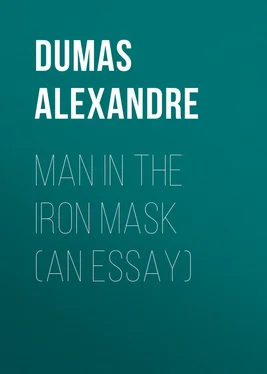Alexandre Dumas - Man in the Iron Mask (an Essay)
Здесь есть возможность читать онлайн «Alexandre Dumas - Man in the Iron Mask (an Essay)» — ознакомительный отрывок электронной книги совершенно бесплатно, а после прочтения отрывка купить полную версию. В некоторых случаях можно слушать аудио, скачать через торрент в формате fb2 и присутствует краткое содержание. Жанр: literature_19, foreign_antique, foreign_prose, на английском языке. Описание произведения, (предисловие) а так же отзывы посетителей доступны на портале библиотеки ЛибКат.
- Название:Man in the Iron Mask (an Essay)
- Автор:
- Жанр:
- Год:неизвестен
- ISBN:нет данных
- Рейтинг книги:3 / 5. Голосов: 1
-
Избранное:Добавить в избранное
- Отзывы:
-
Ваша оценка:
- 60
- 1
- 2
- 3
- 4
- 5
Man in the Iron Mask (an Essay): краткое содержание, описание и аннотация
Предлагаем к чтению аннотацию, описание, краткое содержание или предисловие (зависит от того, что написал сам автор книги «Man in the Iron Mask (an Essay)»). Если вы не нашли необходимую информацию о книге — напишите в комментариях, мы постараемся отыскать её.
Man in the Iron Mask (an Essay) — читать онлайн ознакомительный отрывок
Ниже представлен текст книги, разбитый по страницам. Система сохранения места последней прочитанной страницы, позволяет с удобством читать онлайн бесплатно книгу «Man in the Iron Mask (an Essay)», без необходимости каждый раз заново искать на чём Вы остановились. Поставьте закладку, и сможете в любой момент перейти на страницу, на которой закончили чтение.
Интервал:
Закладка:
There are, of course, objections of all kinds to this theory.
For if, during the four days the comte was at court, he had struck the dauphin, everyone would have heard of the monstrous crime, and yet it is nowhere spoken of, except in the ‘Memoires de Perse’. What renders the story of the blow still more improbable is the difference in age between the two princes. The dauphin, who already had a son, the Duc de Bourgogne, more than a year old, was born the 1st November 1661, and was therefore six years older than the Comte de Vermandois. But the most complete answer to the tale is to be found in a letter written by Barbezieux to Saint-Mars, dated the 13th August 1691: —
“When you have any information to send me relative to the prisoner who has been in your charge for twenty years, I most earnestly enjoin on you to take the same precautions as when you write to M. de Louvois.”
The Comte de Vermandois, the official registration of whose death bears the date 1685, cannot have been twenty years a prisoner in 1691.
Six years after the Man in the Mask had been thus delivered over to the curiosity of the public, the ‘Siecle de Louis XIV’ (2 vols. octavo, Berlin, 1751) was published by Voltaire under the pseudonym of M. de Francheville. Everyone turned to this work, which had been long expected, for details relating to the mysterious prisoner about whom everyone was talking.
Voltaire ventured at length to speak more openly of the prisoner than anyone had hitherto done, and to treat as a matter of history “an event long ignored by all historians.” (vol. ii. p. 11, 1st edition, chap. xxv.). He assigned an approximate date to the beginning of this captivity, “some months after the death of Cardinal Mazarin” (1661); he gave a description of the prisoner, who according to him was “young and dark-complexioned; his figure was above the middle height and well proportioned; his features were exceedingly handsome, and his bearing was noble. When he spoke his voice inspired interest; he never complained of his lot, and gave no hint as to his rank.” Nor was the mask forgotten: “The part which covered the chin was furnished with steel springs, which allowed the prisoner to eat without uncovering his face.” And, lastly, he fixed the date of the death of the nameless captive; who “was buried,” he says, “in 1704., by night, in the parish church of Saint-Paul.”
Voltaire’s narrative coincided with the account given in the ‘Memoires de Peyse’, save for the omission of the incident which, according to the ‘Memoires’, led in the first instance to the imprisonment of Giafer. “The prisoner,” says Voltaire, “was sent to the Iles Sainte-Marguerite, and afterwards to the Bastille, in charge of a trusty official; he wore his mask on the journey, and his escort had orders to shoot him if he took it off. The Marquis de Louvois visited him while he was on the islands, and when speaking to him stood all the time in a respectful attitude. The prisoner was removed to the Bastille in 1690, where he was lodged as comfortably as could be managed in that building; he was supplied with everything he asked for, especially with the finest linen and the costliest lace, in both of which his taste was perfect; he had a guitar to play on, his table was excellent, and the governor rarely sat in his presence.”
Voltaire added a few further details which had been given him by M. de Bernaville, the successor of M. de Saint-Mars, and by an old physician of the Bastille who had attended the prisoner whenever his health required a doctor, but who had never seen his face, although he had “often seen his tongue and his body.” He also asserted that M. de Chamillart was the last minister who was in the secret, and that when his son-in-law, Marshal de la Feuillade, besought him on his knees, de Chamillart being on his deathbed, to tell him the name of the Man in the Iron Mask, the minister replied that he was under a solemn oath never to reveal the secret, it being an affair of state. To all these details, which the marshal acknowledges to be correct, Voltaire adds a remarkable note: “What increases our wonder is, that when the unknown captive was sent to the Iles Sainte-Marguerite no personage of note disappeared from the European stage.”
The story of the Comte de Vermandois and the blow was treated as an absurd and romantic invention, which does not even attempt to keep within the bounds of the possible, by Baron C. (according to P. Marchand, Baron Crunyngen) in a letter inserted in the ‘Bibliotheque raisonnee des Ouvrages des Savants de d’Europe’, June 1745. The discussion was revived somewhat later, however, and a few Dutch scholars were supposed to be responsible for a new theory founded on history; the foundations proving somewhat shaky, however, – a quality which it shares, we must say, with all the other theories which have ever been advanced.
According to this new theory, the masked prisoner was a young foreign nobleman, groom of the chambers to Anne of Austria, and the real father of Louis XIV. This anecdote appears first in a duodecimo volume printed by Pierre Marteau at Cologne in 1692, and which bears the title, ‘The Loves of Anne of Austria, Consort of Louis XIII, with M. le C. D. R., the Real Father of Louis XIV, King of France; being a Minute Account of the Measures taken to give an Heir to the Throne of France, the Influences at Work to bring this to pass, and the Denoument of the Comedy’.
This libel ran through five editions, bearing date successively, 1692, 1693, 1696, 1722, and 1738. In the title of the edition of 1696 the words “Cardinal de Richelieu” are inserted in place of the initials “C. D. R.,” but that this is only a printer’s error everyone who reads the work will perceive. Some have thought the three letters stood for Comte de Riviere, others for Comte de Rochefort, whose ‘Memoires’ compiled by Sandras de Courtilz supply these initials. The author of the book was an Orange writer in the pay of William III, and its object was, he says, “to unveil the great mystery of iniquity which hid the true origin of Louis XIV.” He goes on to remark that “the knowledge of this fraud, although comparatively rare outside France, was widely spread within her borders. The well-known coldness of Louis XIII; the extraordinary birth of Louis-Dieudonne, so called because he was born in the twenty-third year of a childless marriage, and several other remarkable circumstances connected with the birth, all point clearly to a father other than the prince, who with great effrontery is passed off by his adherents as such. The famous barricades of Paris, and the organised revolt led by distinguished men against Louis XIV on his accession to the throne, proclaimed aloud the king’s illegitimacy, so that it rang through the country; and as the accusation had reason on its side, hardly anyone doubted its truth.”
We give below a short abstract of the narrative, the plot of which is rather skilfully constructed: —
“Cardinal Richelieu, looking with satisfied pride at the love of Gaston, Duc d’Orleans, brother of the king, for his niece Parisiatis (Madame de Combalet), formed the plan of uniting the young couple in marriage. Gaston taking the suggestion as an insult, struck the cardinal. Pere Joseph then tried to gain the cardinal’s consent and that of his niece to an attempt to deprive Gaston of the throne, which the childless marriage of Louis XIII seemed to assure him. A young man, the C. D. R. of the book, was introduced into Anne of Austria’s room, who though a wife in name had long been a widow in reality. She defended herself but feebly, and on seeing the cardinal next day said to him, ‘Well, you have had your wicked will; but take good care, sir cardinal, that I may find above the mercy and goodness which you have tried by many pious sophistries to convince me is awaiting me. Watch over my soul, I charge you, for I have yielded!’ The queen having given herself up to love for some time, the joyful news that she would soon become a mother began to spread over the kingdom. In this manner was born Louis XIV, the putative son of Louis XIII. If this instalment of the tale be favourably received, says the pamphleteer, the sequel will soon follow, in which the sad fate of C. D. R. will be related, who was made to pay dearly for his short-lived pleasure.”
Читать дальшеИнтервал:
Закладка:
Похожие книги на «Man in the Iron Mask (an Essay)»
Представляем Вашему вниманию похожие книги на «Man in the Iron Mask (an Essay)» списком для выбора. Мы отобрали схожую по названию и смыслу литературу в надежде предоставить читателям больше вариантов отыскать новые, интересные, ещё непрочитанные произведения.
Обсуждение, отзывы о книге «Man in the Iron Mask (an Essay)» и просто собственные мнения читателей. Оставьте ваши комментарии, напишите, что Вы думаете о произведении, его смысле или главных героях. Укажите что конкретно понравилось, а что нет, и почему Вы так считаете.












